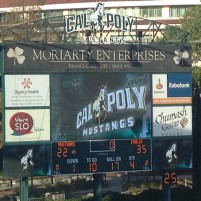California School Pays $480,000 To Remove Schemer's Name From Scoreboard
 credit: calcoastnews.comA California university will pay nearly half a million dollars to remove the name of a man convicted of running a $22 million Ponzi scheme from a 53-foot advertisement on a scoreboard in the school's athletic facility. California Polytechnic State University, San Luis Obispo ("Cal Poly") will end a dispute that has spanned nearly one year by paying $480,000 to a bankruptcy trustee tasked with recovering funds on behalf of victims scammed by Al Moriarty. While a bankruptcy judge must still approve the settlement, the school hopes that approval will come before the football team's home opener on September 19th.
credit: calcoastnews.comA California university will pay nearly half a million dollars to remove the name of a man convicted of running a $22 million Ponzi scheme from a 53-foot advertisement on a scoreboard in the school's athletic facility. California Polytechnic State University, San Luis Obispo ("Cal Poly") will end a dispute that has spanned nearly one year by paying $480,000 to a bankruptcy trustee tasked with recovering funds on behalf of victims scammed by Al Moriarty. While a bankruptcy judge must still approve the settlement, the school hopes that approval will come before the football team's home opener on September 19th.
Moriarty was a Grover Beach businessman who was well known in the community for his philanthropy, having donated extensively to area charities and also coaching various community sporting teams. Beginning in the early 1990's, Moriarty used his company, Moriarty Enterprises, to solicit potential investors with the promise of 10% returns purportedly derived from providing home loans to educators. While specifics on the investments remain unknown, Moriarty was able to raise tens of millions of dollars from dozens of investors.
While the investments initially performed as promised, Moriarty began defaulting on scheduled interest payments during the economic downturn due to what he blamed on financial headwinds. Investors turned to the courts when Moriarty defaulted, and nearly 20 lawsuits were pending against Moriarty in November 2012. Moriarty would file for bankruptcy the following month. A criminal investigation ensued and culminated in Moriarty's arrest in May 2013. He was charged with seven felonies, including the fraudulent sale of securities and material misstatements and omissions in connection with the sale of securities. Moriarty pleaded no contest to the charges on August 4, 2014, and received a five-year prison sentence on September 17, 2014. According to the San Luis Obispo Sheriff's Office, Moriarty is due to be released from prison on December 20, 2015, despite serving less than 1/3 of that sentence.
Moriarty was known not only for his philanthropy, but also for his extensive ties to local and national athletics. His wife, Patricia Rooney, is part of the iconic family that owns the Pittsburgh Steelers. Moriarty played football at Cal Poly, and also previously coached local football and basketball teams. As a Cal Poly alumnus, Moriarty donated generously to his alma mater, This generosity included the donation of $625,000 in 2009 in exchange for the prominent placement of Moriarty Enterprises on Cal Poly's football stadium.
Despite Moriarty's bankruptcy filing and subsequent arrest, the name "Moriarty Enterprises" still remained prominently featured on the scoreboard at Cal Poly's Alex G. Spanos Stadium. Indeed, because of his bankruptcy filing, the naming rights to the stadium were transferred to the bankruptcy trustee in an effort to realize potential value for creditors.
The school was well aware that any action taken to modify or remove the scoreboard could result in severe financial consequences - including punitive damages and the possibility of being held in contempt. After Cal Poly balked at repaying the $625,000 received from Moriarty, the trustee filed a lawsuit seeking the return of the funds and claiming that Moriarty was insolvent at the time the donation was made. A bankruptcy judge later ordered Cal Poly to resolve the lawsuit before removing the name.
The scoreboard has been covered since mid-June while Cal Poly and the trustee participated in a court-ordered mediation. In resolving the trustee's lawsuit, Cal Poly has agreed to pay $480,000 - funds that will be paid from a school foundation rather than sourced from school tuition. Cal Poly has indicated that it plans to cover the name with either "#CalPoly" or "Go Cal Poly" before the September 19th home opener.

